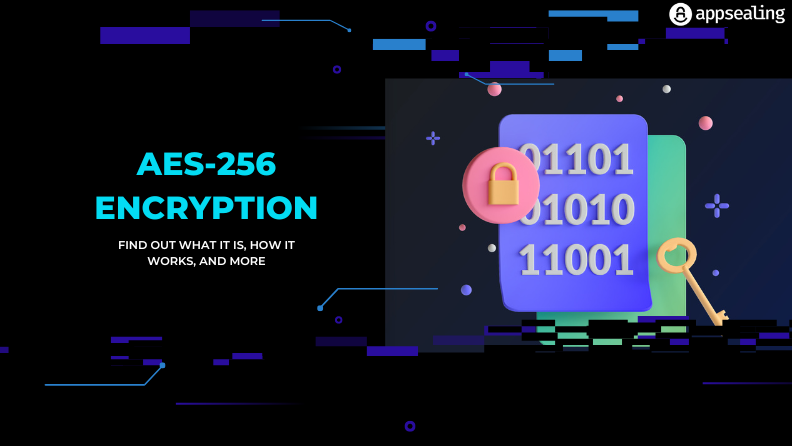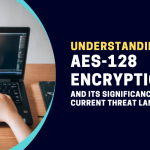
Encryption standards are getting stronger as hackers are constantly trying to exploit security loopholes. Up until recently, Data Encryption Standard (DES) was the main standard for encrypting data. Advanced Encryption Standard was published in 2001 when DES proved inadequate in the context of the current threat landscape. Advanced Encryption Standard (AES) is an encryption method that provides strong protection against unauthorized access. AES was initially adopted by the federal government to protect confidential information on national security. AES comes in 128-bit, 192-bit, and 256-bit. AES-256 is currently the most secure encryption. This article will shed light on everything you need to know about AES-256.
AES-256 Encryption
AES comes in 128, 192, and 256 bits. AES-256 uses a 256-bit key to convert plain text into cipher. AES-256 supports the largest bit size and is a widely used encryption technology because it is virtually impenetrable to brute-force attacks. It protects sensitive information, controlled unclassified information (CUI), and classified information. The AES-256 algorithm is extremely difficult or rather impossible to crack.
How Does AES-256 Encryption Work?
Encryption works by converting plain text into an unreadable cipher code. AES is a symmetric key cipher that uses the same key for encryption and decryption. Symmetric keys are faster and more efficient than asymmetric keys as they require less computational power. AES encryption divides information to be encrypted into sections called blocks. It involves replacing different bytes, shifting rows and mixing columns, and scrambling the information. The result is a random set of characters that cannot be read without a decryption key. AES-256 completes 14 rounds of encryption to encode data. It offers additional security as it involves a key expansion process. The initial key leads to a series of new keys called round keys. Multiple rounds of modification generate round keys. This process enhances security making it harder for unauthorized users to break the encryption. AES-256 is the longest and strongest encryption. A hacker will have to try 2256 distinct combinations to break the encryption.
Let’s understand the steps involved in AES-256 encryption:
- Information division
Division of information into blocks is the first step to encrypting data using AES-256 encryption. The information gets divided into 4×4 columns of 16 bytes in this stage of encryption. - Key expansion
The AES algorithm recreates multiple round keys from the first key. It relies on the Rijndaels key schedule to recreate round keys. - Round key addition
Adding the round key involves inserting the initial round key into the data which is subdivided into 4×4 blocks. - Substituting bytes
Each byte of data substitutes another byte of data in this step. - Row shifting
This step involves shifting rows of the 4X4 arrangement. It shifts the bytes on the second row one space to the left, bytes on the third row to two spaces left, and so on. - Mixing columns
This step involves using a pre-established matrix to mix the 4X4 columns of the data array. - Second-round key addition
The algorithm repeats the process with another round of key addition in this step.
This process results in cipher text that is not decipherable. Each step of encryption is significant. Round keys serve as an important tool to make the data more complex to decipher. Byte substitution involves data modification in a non-linear manner. Row shifting and column mixing yield ciphertext that is much more sophisticated resulting in a stronger form of encryption.
What makes AES 256 special and why should you use it?
AES-256 is the encryption key length recommended for safeguarding top-secret information. Let’s understand the features that make AES-256 special and why people should use it for safeguarding their data.
1. AES-256 is unbreakable by brute force
Data protected by AES 256 is unbreakable by brute force. It is the strongest encryption and is almost impossible to break. A brute force attack is when a hacker checks different key combinations until he/she arrives at the correct combination. The larger the key size, the more difficult it becomes to break the encryption. Breaking AES-256 will require large amounts of computing power making it impossible for malicious actors to generate the necessary brute force to break AES-256 encryption.
2. AES uses symmetric encryption
There are two types of encryption namely symmetric and asymmetric. Symmetric encryption uses the same key for encryption and decryption whereas asymmetric encryption relies on two different keys for encryption and decryption. AES uses symmetric encryption which offers the following benefits:
- Suitable for internal encryption
- Greater speed
- Recommended for protecting large volumes of data
- Runs on less computational power
3. AES-256 prevents data breaches
A security breach results in irreparable damages for most businesses. One breach is all it takes to destroy the reputation earned over the years. AES-256 encryption can control the damage rising from a security breach and prevent precious data from getting into the hands of threat actors. The extent of damage depends on a few important factors which are as follows:
- Time taken by the organization to identify a security breach
- The ability of the enterprise to contain the damage in the event of a breach
- Provision for contingencies
Implementing AES-256 encryption is an effective method to prevent the security event from directly affecting the data. AES-256 encryption will protect the data from unauthorized users even if the security of the infrastructure gets compromised by chance. The encryption acts as a protective shield preventing hackers from accessing the data. It saves your organization from compliance issues, ransomware attacks, and data theft.
4. AES-256 provides the most security
AES-256 serves as a future-proof framework for protecting data against sophisticated attacks. AES 128 and AES 192 encryption algorithms are complex enough. But AES 256 provides protection even from quantum computers which are touted to become popular in the future. AES-256 is a complex encryption algorithm that is designed by keeping future applications and the threat landscape in mind.
Is AES-256 Encryption Crackable?
The difference between DES and AES is that a 56-bit DES can be easily cracked whereas AES cannot be cracked. It would take billions of years for malicious actors to break AES with the current computing technology. Hence, AES is trusted by government organizations to protect top confidential information. AES cannot be broken with brute-force attacks.
However, no encryption system is 100% secure. There have been instances where attempts to break the encryption were made. A related-key attack was identified in 2009 where the hacker attempted to crack the code with cryptanalysis. The attack however was a result of incorrect configuration. AES systems with incorrect configurations are susceptible to attacks. There was yet another attempt to break the AES 128 encryption with a known-key attack. However, the attack was on the 8-round version of the encryption model rather than the commonly used 10-round version.
Brute-force attacks are never successful with AES encryption in place. However, side-channel attacks pose a threat to this encryption model. Side-channel attacks pry on information leaked from the system. Threat actors pick on electromagnetic signals, sounds, or other information such as power consumption to understand what the computing device does when performing cryptographic operations. Side channel attacks use this information to reverse-engineer the device’s cryptography system. For example, optical information from a high-resolution camera can be used to comprehend how the system is processing the AES encryption.
The best way to prevent side-channel attacks is to prevent data leaks. Randomization techniques are beneficial to eliminate evidence of any relationship between data leaked and the data protected with encryption. Side-channel attacks cannot break the encryption when hackers cannot figure out the relationship between the data.
No encryption method is secure if the implementation itself is flawed. Implementation needs to be done right to reap the full benefits of the encryption model. Protecting the encryption key is vital to ensure AES remains unbreakable. Here are a few security measures that organizations must deploy for protecting encryption keys:
- Create strong passwords
- Use multi-factor authentication
- Implement firewalls and antivirus software
- Educate employees of the organization against social engineering and phishing attacks
Lack of awareness among users is one of the most important contributing factors to compromised security. Users with an awareness of security measures can prevent attacks in more ways than one. Imparting proper training on how to handle sensitive information can safeguard data against attacks and protect the enterprise from data breaches occurring due to negligence.
Can AES work in isolation?
By now, you must be convinced that AES is the most secure encryption standard. But if you think implementing AES is all you need to do to ensure security, you are wrong. AES cannot work in isolation. You cannot skip other security measures just because you are deploying AES for data encryption. AES is effective only if you use it in conjunction with other security measures. You cannot expect AES to make up for all the security flaws in your system. Weak infrastructure will ultimately grant hackers access to data. If your organization’s infrastructure is weak, the following outcomes are inevitable:
- Hackers will gain access to cryptographic keys
- Threat actors may launch side-channel attacks
- Unauthorized users will access data before and after encryption
Implementing a Managed File Transfer (MFT) is critical to support AES-256 encryption. AES-256 will produce the desired benefits only if the surrounding infrastructure is strong. MFT will ensure strict access control so no cryptographic keys are leaked. Any hacker that gains access to cryptographic keys can easily break the encryption. MFT keeps the keys out of hackers’ hands.
Multifactor authentication is another must-have security feature. Multi-factor authentication provides additional security for users and accounts. It ensures no unauthorized user accesses the infrastructure. Multi-factor authentication ensures threat actors don’t gain access to information systems such as billing systems, remote access technology, or email even if passwords are compromised in phishing attacks.
Report of file access is yet another critical security measure to ensure the security of AES encryption is not compromised. It gives real-time visibility into hacking attempts which helps the organization become proactive with its security measures.
Hackers are constantly aiming for the weakest point in the system to break the encryption. If you leave any areas unaddressed, it could easily lead to security breaches. Every organization must ensure the system has no weak points. Employees must be up to date with the latest security best practices and all users should be on the same page about security implementation.
Final Thoughts
The open nature of AES makes it one of the most secure encryption standards. Security professionals are constantly looking out for vulnerabilities in this encryption model so immediate action can be taken if any vulnerabilities are discovered. Popular programming languages like C, C++, Java, and Python use AES libraries. AES is also one of the most relied-on encryption methods by VPN providers for protecting their databases.
Popular applications like WhatsApp use AES-256 to encrypt messages. AES instructions are by default built into computers with Intel and AMD processors. Google Cloud is another great example of AES-256 encryption in action. Organizations that deal with highly sensitive data use AES-256. AES-256 is more suitable for environments where security is more important than speed. 256-bit is the longest key that provides the strongest encryption. What it means is that a hacker will have to try 2256 varied combinations to get the right one. The resultant figure is 78 digits long. A hacker cannot try these many combinations in this lifetime. This is why AES-256 is the preferred data protection method for the US government. Financial institutions too rely on AES-256 to protect their data.
AppSealing is a comprehensive mobile app security solutions provider that will help you tackle threats associated with data theft and data leaks with the implementation of appropriate security measures. With robust in-app protection, it ensures hackers don’t manipulate data or compromise the security of mobile applications. Data encryption needs the support of a secure ecosystem to function properly. We will provide a no-code mobile app security solution to safeguard your data within minutes. Get in touch with AppSealing to secure your data at rest and in transit with a host of security measures such as stricter access controls, multi-factor authentication, and more.





